The use of capacitive touch switch technology is widespread and becoming more frequent each day. Capacitive touch switches are common on thousands of everyday devices including gas station pumps, smartphones, lamps, automobile dashboards, and even the smart speaker in your home.
Some of the benefits of using a capacitive touch switch are its customization ability, transparency options (allowing for a wide range of backlighting options), and there are no moving parts.
These types of switches offer a high reliability and low-cost solution for applications that can benefit from a low-profile switch design. Capacitive touch switches can be incorporated into complex backlighting schemes or sleek faceplates offering that nextgen look designers strive for.
Capacitive touch switches operate by creating an electric field that is continuously monitored by a microcontroller. Upon disturbing the electric field, changes in capacitance are sensed, triggering a switch closure event. The capacitance change in the electric field can be triggered by a human finger, gloved finger, stylus, or anything with similar electrical properties to a human finger. The capacitive touch switches can then be calibrated to respond appropriately for the intended use case.
Breaking Things Down: Capacitive Touch Switch Sensor Design
The actual sensors or electrodes on a capacitive touch switch are quite simple in design. For a capacitive touch switch to function, both positive and negative polarity conductive features must be designed with an air gap or insulating material separating the two. The electrodes’ exact shape is not critical. In fact, the electrodes shape can be customized to any shape of switch required. Their shape can be a circle, square, or even a large customized shape. What is important is that the electrodes are fabricated using a conductive material and that there are both positive and negative polarity sides of the electrode.
On these types of switches, the electrical signals are routed off the switch panel via a tail, flat flexible cable, or other type of wire harness. The end of the flex tail or cable can be terminated with any appropriate connector as no specialty interconnects are required for supporting capacitive touch technologies.
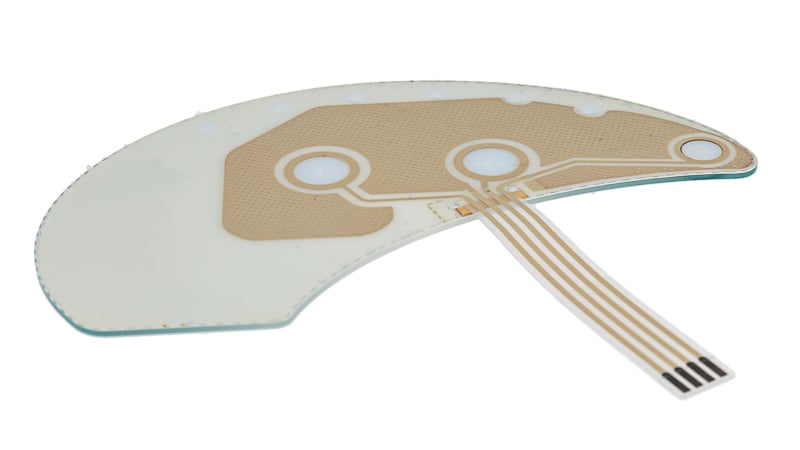
Capacitive touch switch showing circuit layer.
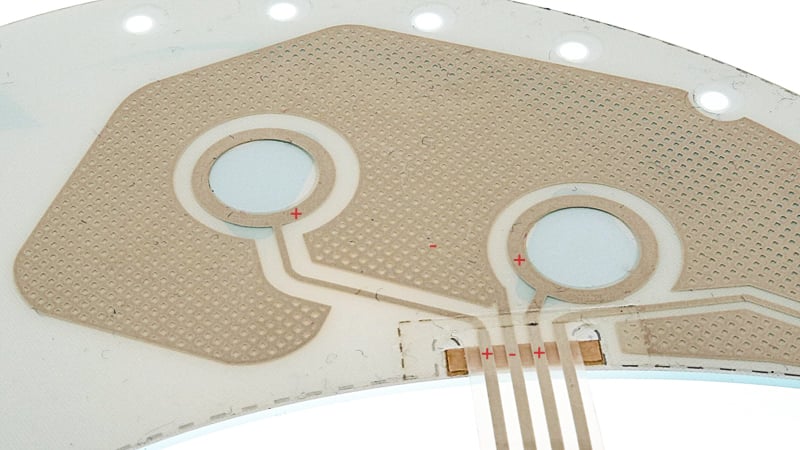
Capacitive touch switch - sensor pad design and polarity.
Breaking Things Down: Transparent Capacitive Touch Switch Options
Like any other circuit, some type of conductive material is required for the circuit to operate. The most common material for the capacitive touch sensor pads is copper. This is the primary conductive material in most rigid PCBs and flex circuits. But since capacitive touch switches can use lower-cost circuit options like polyester with screened on silver ink, these are viable options for consideration. However, if your design requires the use of a transparent capacitive touch switch, using copper or conductive silver ink requires some additional consideration.
1. Design the Capacitive Touch Switch Using Annual Rings
This type of design option uses conductive materials like copper or conductive ink, but the shape of the sensor pad provides a “transparent” window in the center of the switch with conductive material around the perimeter. This type of switch provides minimal risk in the material selection, but the shape, size, and operation of the switch itself must be tested. The capacitance field created must be sized to be able to detect a switch registration with the paired microcontroller. It’s recommended to mockup the final design and incorporate the overlay or any additional material layers for the evaluation.
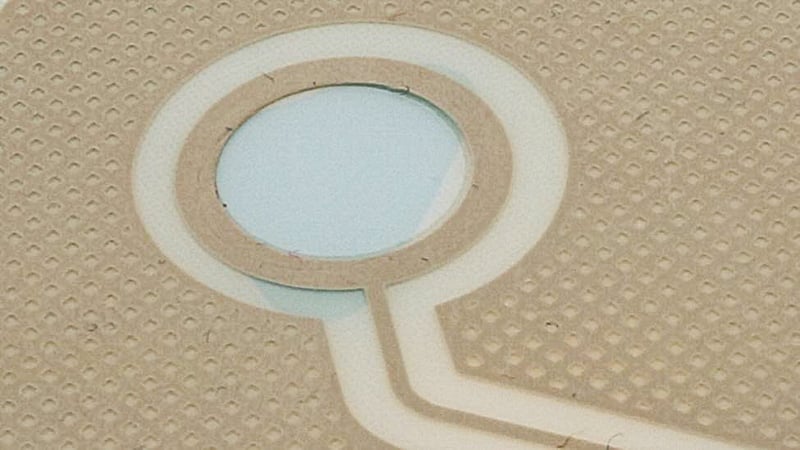
Annual ring sensor pad with screened on conductive ink.
2. Incorporate Transparent Conductive Materials
The use of transparent conductive materials is common in products such as touchscreens, transparent heaters, optically clear antennas, etc. These applications require a transparent circuit while providing some type of electrical function for the product. The same is true for some types of capacitive touch switches and their use of transparent conductive materials.
The two most common materials used are ITO and transparent ink. There are additional transparent highly conductive materials that are more exotic and best considered for specialty applications outside the world of touchscreens and capacitive touch switches. Indium tin oxide (ITO) is a material that when applied to substrates as a thin film, exhibits exceptional electrical conductivity and optical transparency.
There are also transparent conductive inks that can be screened on to a flexible substrate like PET (polyester), providing an optically clear circuit. Typically, these materials offer a 70% or greater optical transmission, with much of this performance coming from how the material is applied and how the additional layers are laminated to one another.
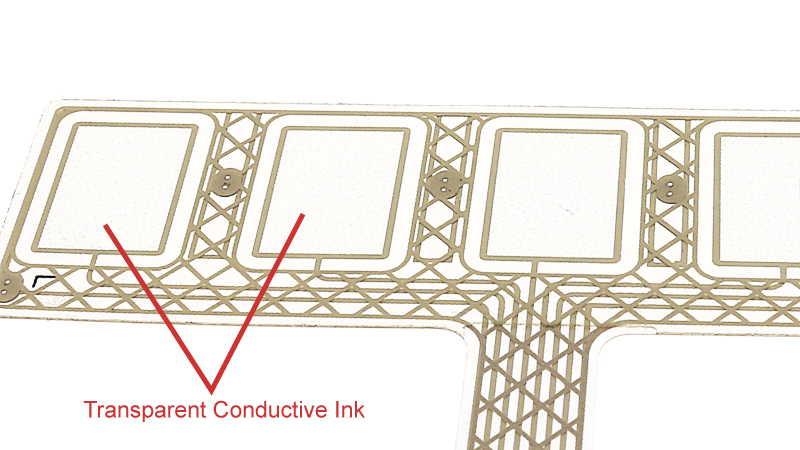
5-button capacitive touch switch with transparent conductive ink.
3. Incorporate Backlighting Above the Circuit
If the ultimate goal is to develop a sophisticated backlighting scheme, this can be accomplished through the use of an ordinary FR4 + copper base circuit with an integrated light guide film (LGF). Although the capacitive touch sensors are not transparent themselves, sandwiching the LGF layer between the circuit and overlay surface allows for the switches to be uniformly backlit, providing the appearance the button is “transparent.” The LGF works by placing a side firing LED within the laminated stack-up residing outside the viewing window. The LGF film helps disburse light to the desired areas. Although the circuit design is straightforward, care must be taken to properly select and size the overlay material since the dielectric constant and material thickness can negatively impact capacitive touch responsiveness. As always with any new design or product development activity, we recommend extensive testing to characterize and develop the switch system.
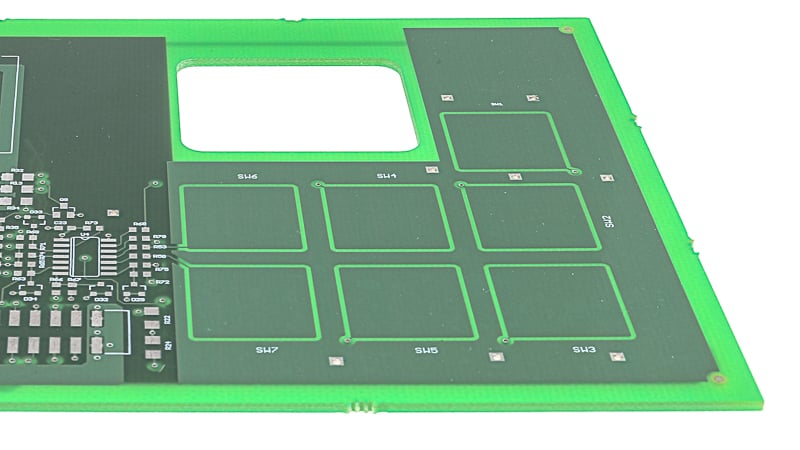
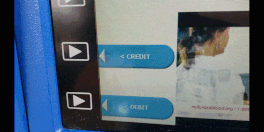
Example of a finger pressing a capacitive touch switch.
Additional Considerations
Raw material manufacturers invest heavily to develop proprietary blends of conductive inks, especially those exhibiting transparent qualities. It’s not just transparent inks that material suppliers develop.
Some transparent capacitive touch panels use ultra-fine meshes that are not visible unless examined under magnification. These technologies use thin wire meshes of conductive materials and build a grid-like structure. Imagine the insect screen in your home’s window but much smaller and designed for high-electrical conductivity. The intellectual property for many of these materials (both inks and meshes), processes, and the physical characteristics themselves is somewhat limited. Data sheets contain minimal information since some manufacturers are reluctant to share even the most arbitrary information. This means that samples and testing are critical before any design freeze since the exact electrical conductivity or optical transparency may be missing from the data sheets you desire. Plan on including a small quantity of samples for development in your build plan.
Summary
There are many similarities between a standard membrane switch and a capacitive touch switch. This fact is also true for capacitive touch switches that incorporate some type of transparent button technology. These devices use thin layers of polyester and adhesive and sandwich a delicate low-profile electrical circuit in between. There are often low-tech discrete devices like LEDs, resistors, and ZIF tail connectors included as well, but the similarities end there. Capacitive touch switches require a completely different and unique type of system for them to operate, whereas membrane switches generally behave as normally open switches, similar to a “light switch.” A microcontroller, compiled source code, calibration, and additional integration steps are needed to bring life to a capacitive touch switch.
Capacitive touch devices are an excellent choice for products that require ultra-high reliability, additional levels of customization, and the sleek nextgen look and feel that many designers strive for. Incorporating transparent buttons and switches into the capacitive touch class of product allows for even more customization and advanced functionality for designers and engineers. The use of this technology also opens the door for options that include selective backlighting, buttons that can serve as viewing windows, and other advanced forms of backlight integration. It’s clear that not all projects warrant the additional development required for integrating a capacitive touch switch, but if transparent switches are required for your project, there is no better choice than a capacitive touch switch designed by Epec.
Key Takeaways
- Capacitive touch switches: Provide sleek, low-profile, and highly reliable interfaces with no moving parts, making them ideal for modern applications like automotive dashboards, smart devices, and complex backlit designs.
- Transparent capacitive switches can be achieved through three main approaches: using annular ring designs with traditional conductive materials, incorporating transparent conductive materials like ITO or conductive inks, or combining opaque circuits with light guide films for advanced backlighting effects.
- Material selection is critical for transparency and performance: Indium tin oxide (ITO), transparent conductive inks, and ultra-fine conductive meshes are common options, but these require careful evaluation and testing due to limited material data availability.
- Integration with microcontrollers is essential: Unlike simple membrane switches, capacitive touch switches rely on microcontrollers for calibration, signal processing, and proper response tuning, requiring additional system-level design considerations.
- Thorough prototyping and testing are necessary: Because material properties and switch performance can vary widely, early mockups and evaluations of the full stack-up, including overlays, adhesives, and backlighting, are vital to ensure reliable operation and responsiveness.
















